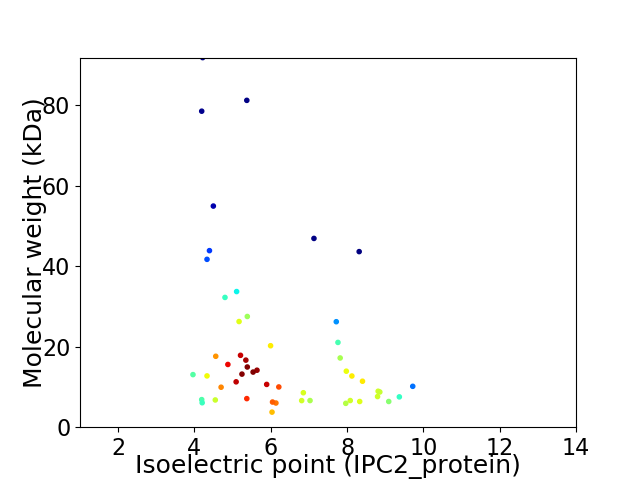
Pseudoalteromonas phage H105/1
Taxonomy: Viruses; Duplodnaviria; Heunggongvirae; Uroviricota; Caudoviricetes; Caudovirales; Siphoviridae; unclassified Siphoviridae
Average proteome isoelectric point is 6.22
Get precalculated fractions of proteins

Virtual 2D-PAGE plot for 52 proteins (isoelectric point calculated using IPC2_protein)
Get csv file with sequences according to given criteria:
* You can choose from 21 different methods for calculating isoelectric point
Summary statistics related to proteome-wise predictions



Protein with the lowest isoelectric point:
>tr|E1AC18|E1AC18_9CAUD Conserved hypothetical phage protein OS=Pseudoalteromonas phage H105/1 OX=877240 PE=4 SV=1
MM1 pKa = 6.88TTLKK5 pKa = 10.89SEE7 pKa = 4.29FQEE10 pKa = 4.28LAAEE14 pKa = 4.95LIDD17 pKa = 6.07DD18 pKa = 4.71EE19 pKa = 5.07FADD22 pKa = 4.4FQRR25 pKa = 11.84PFIIKK30 pKa = 10.36KK31 pKa = 9.81NGDD34 pKa = 3.51YY35 pKa = 11.22SPVTGEE41 pKa = 4.09SPSFNAEE48 pKa = 3.55TGAIPLDD55 pKa = 3.62LKK57 pKa = 9.8TAEE60 pKa = 4.3KK61 pKa = 10.86VFTNVTSSEE70 pKa = 4.07IYY72 pKa = 10.64LVILNAAPVPSDD84 pKa = 3.16FDD86 pKa = 3.78EE87 pKa = 5.58SYY89 pKa = 8.98HH90 pKa = 6.44CSYY93 pKa = 11.39NGVDD97 pKa = 3.44YY98 pKa = 10.86DD99 pKa = 3.83INQVEE104 pKa = 4.86GDD106 pKa = 4.05PADD109 pKa = 3.04AAYY112 pKa = 9.61FVRR115 pKa = 11.84IVII118 pKa = 4.24
MM1 pKa = 6.88TTLKK5 pKa = 10.89SEE7 pKa = 4.29FQEE10 pKa = 4.28LAAEE14 pKa = 4.95LIDD17 pKa = 6.07DD18 pKa = 4.71EE19 pKa = 5.07FADD22 pKa = 4.4FQRR25 pKa = 11.84PFIIKK30 pKa = 10.36KK31 pKa = 9.81NGDD34 pKa = 3.51YY35 pKa = 11.22SPVTGEE41 pKa = 4.09SPSFNAEE48 pKa = 3.55TGAIPLDD55 pKa = 3.62LKK57 pKa = 9.8TAEE60 pKa = 4.3KK61 pKa = 10.86VFTNVTSSEE70 pKa = 4.07IYY72 pKa = 10.64LVILNAAPVPSDD84 pKa = 3.16FDD86 pKa = 3.78EE87 pKa = 5.58SYY89 pKa = 8.98HH90 pKa = 6.44CSYY93 pKa = 11.39NGVDD97 pKa = 3.44YY98 pKa = 10.86DD99 pKa = 3.83INQVEE104 pKa = 4.86GDD106 pKa = 4.05PADD109 pKa = 3.04AAYY112 pKa = 9.61FVRR115 pKa = 11.84IVII118 pKa = 4.24
Molecular weight: 13.07 kDa
Isoelectric point according different methods:
Protein with the highest isoelectric point:
>tr|E1ABZ6|E1ABZ6_9CAUD Uncharacterized protein OS=Pseudoalteromonas phage H105/1 OX=877240 PE=4 SV=1
MM1 pKa = 7.23NAGAGVIEE9 pKa = 4.39CQYY12 pKa = 10.94LYY14 pKa = 10.97LILYY18 pKa = 8.79PMYY21 pKa = 10.93LITNYY26 pKa = 10.37LWLITLAMVSFLTLRR41 pKa = 11.84CRR43 pKa = 11.84AISLRR48 pKa = 11.84DD49 pKa = 3.8AITEE53 pKa = 3.91KK54 pKa = 11.16GLIKK58 pKa = 10.47ALSLIMRR65 pKa = 11.84RR66 pKa = 11.84FSGYY70 pKa = 8.22RR71 pKa = 11.84TLRR74 pKa = 11.84LKK76 pKa = 10.82ALAKK80 pKa = 10.01RR81 pKa = 11.84LPFFACNN88 pKa = 3.21
MM1 pKa = 7.23NAGAGVIEE9 pKa = 4.39CQYY12 pKa = 10.94LYY14 pKa = 10.97LILYY18 pKa = 8.79PMYY21 pKa = 10.93LITNYY26 pKa = 10.37LWLITLAMVSFLTLRR41 pKa = 11.84CRR43 pKa = 11.84AISLRR48 pKa = 11.84DD49 pKa = 3.8AITEE53 pKa = 3.91KK54 pKa = 11.16GLIKK58 pKa = 10.47ALSLIMRR65 pKa = 11.84RR66 pKa = 11.84FSGYY70 pKa = 8.22RR71 pKa = 11.84TLRR74 pKa = 11.84LKK76 pKa = 10.82ALAKK80 pKa = 10.01RR81 pKa = 11.84LPFFACNN88 pKa = 3.21
Molecular weight: 10.16 kDa
Isoelectric point according different methods:
Peptides (in silico digests for buttom-up proteomics)
Below you can find in silico digests of the whole proteome with Trypsin, Chymotrypsin, Trypsin+LysC, LysN, ArgC proteases suitable for different mass spec machines.| Try ESI |
 |
|---|
| ChTry ESI |
 |
|---|
| ArgC ESI |
 |
|---|
| LysN ESI |
 |
|---|
| TryLysC ESI |
 |
|---|
| Try MALDI |
 |
|---|
| ChTry MALDI |
 |
|---|
| ArgC MALDI |
 |
|---|
| LysN MALDI |
 |
|---|
| TryLysC MALDI |
 |
|---|
| Try LTQ |
 |
|---|
| ChTry LTQ |
 |
|---|
| ArgC LTQ |
 |
|---|
| LysN LTQ |
 |
|---|
| TryLysC LTQ |
 |
|---|
| Try MSlow |
 |
|---|
| ChTry MSlow |
 |
|---|
| ArgC MSlow |
 |
|---|
| LysN MSlow |
 |
|---|
| TryLysC MSlow |
 |
|---|
| Try MShigh |
 |
|---|
| ChTry MShigh |
 |
|---|
| ArgC MShigh |
 |
|---|
| LysN MShigh |
 |
|---|
| TryLysC MShigh |
 |
|---|
General Statistics
Number of major isoforms |
Number of additional isoforms |
Number of all proteins |
Number of amino acids |
Min. Seq. Length |
Max. Seq. Length |
Avg. Seq. Length |
Avg. Mol. Weight |
|---|---|---|---|---|---|---|---|
0 |
9503 |
33 |
866 |
182.8 |
20.18 |
Amino acid frequency
Ala |
Cys |
Asp |
Glu |
Phe |
Gly |
His |
Ile |
Lys |
Leu |
|---|---|---|---|---|---|---|---|---|---|
8.524 ± 0.652 | 1.084 ± 0.159 |
6.577 ± 0.308 | 6.577 ± 0.453 |
4.051 ± 0.251 | 7.345 ± 0.461 |
0.958 ± 0.146 | 6.608 ± 0.299 |
6.64 ± 0.503 | 8.197 ± 0.446 |
Met |
Asn |
Gln |
Pro |
Arg |
Ser |
Thr |
Val |
Trp |
Tyr |
|---|---|---|---|---|---|---|---|---|---|
2.252 ± 0.29 | 5.64 ± 0.296 |
2.673 ± 0.268 | 4.335 ± 0.407 |
4.136 ± 0.347 | 7.766 ± 0.425 |
6.198 ± 0.368 | 6.072 ± 0.308 |
0.8 ± 0.117 | 3.567 ± 0.236 |
Most of the basic statistics you can see at this page can be downloaded from this CSV file
Proteome-pI is available under Creative Commons Attribution-NoDerivs license, for more details see here
| Reference: Kozlowski LP. Proteome-pI 2.0: Proteome Isoelectric Point Database Update. Nucleic Acids Res. 2021, doi: 10.1093/nar/gkab944 | Contact: Lukasz P. Kozlowski |
